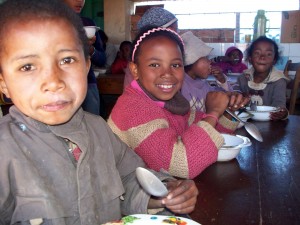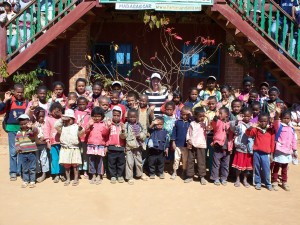After a two-hour drive along twisting roads that might not be considered paved by Western standards, the pickup turned up a pitted and trenched dirt road that climbed to the top of the mountain. Alex Châteaux, founder and president of La Maison d’Aïna—and also our driver—waved to two men trying to fill in some of the potholes. They were fathers of some of the LMA kids who received a salary from the organization, even though all their hard work would be washed away in the rainy season. Oilizo, the beaming Malagasy LMA coordinator, made a quick phone call and told Alex that everything was ready. I didn’t quite register her words until we reached the school grounds.
Hundreds of children in uniforms, dingy but neat, lined the road, smiling and waving at us. Well, at me, the guest. They looked so happy. So incredibly carefree. I shouted back to as many as I could, trying my best to wave at all the kids on either side without blocking Alex’s view out the windshield. He was smiling, too, a knowing smile. They organize this welcome, the warmest of welcomes, the specialty of people in Madagascar, for every guest, and all guests feel equally as impressed and humbled, equally a part of a new, wonderful family.
But that was all just before we even got out of the pickup. As soon as my feet touched the ground, all the kids scurried into straight lines by class for the performance portion of the afternoon. They danced, they sang, sometimes in French, sometimes in Malagasy, always beaming. It’s hard to describe the sheer joy of a song that the kids have sung a thousand times that they still love to sing. There’s no requirement to sing for guests (although a few do have a bit of stage fright). They just love to do it.
Finally, I got a tour of the whole place, a group of mud and brick buildings set on the top of a mountain. I’d already seen the courtyard, with an open space to run around (or dance in) and a full playground on the other end, complete with a kid-sized stone train with built-in slide. The main class building was sturdily constructed around the organization’s origins, a pair of shipping containers. The larger building across the path held more classrooms, a colorful and cozy library, a tiny office, and the first half of the machine shop, which is slated for expansion soon. To the back, a low kitchen and lunchroom, with disused foosball tables shoved awkwardly against the walls.
I tried to remember everyone’s names, but it was a doomed endeavor from the start. There were the teachers for the hundred-plus kids, but there were also all the parents who help out at LMA. Some have full-time jobs as cooks or watchmen, and the rest all pitch in at least half an hour of work per week for each child they have enrolled. It helps all of them earn a living, or at least make ends meet.

The children and families who are accepted into the LMA family are some of the poorest people in one of the world’s poorest countries. Everything we think in the West about mud houses, and two-mile-long treks to the stream for water, and families living on less than a dollar a day, it’s all true. It’s all shockingly true, and hard to mentally accept. But this is why organizations like La Maison d’Aïna exist, and they’re doing a darned good job.
La Maison d’Aïna was founded over a decade ago with the goal of educating poor and sometimes orphaned children in the countryside around Ambatolampy, just south of the capital city of Antananarivo. The genius of Alex Châteaux and his wife, Hanta, is how quickly they realized—and took action on—the fact that other basic necessities had to be fulfilled in order for that education to be effective, or even possible. Children can’t learn if they’re hungry, so LMA provides every child, teacher, and parent worker with a hot lunch and filling snack every day. Children also can’t learn if they’re cold, so LMA provides clothes for every child, whether they’re sponsored or not, from shoes to coats to underwear. Children can’t learn if they’re sick, so LMA makes sure that all the kids get the medical attention they need to stay healthy from the nurse in the next town over.
Most importantly, though, children won’t stay in school—or commit to much of anything—if they don’t feel loved, appreciated, and special, so Alex and the LMA team make sure all the kids receive affection in multiple ways. The kids are allowed special excursions to the market and sleepovers at the school on a rotating schedule. They’re given hugs liberally and told that they’re loved, which is especially crucial for the kids whose parents are absent or deceased. Finally, every child is followed and supported until the point of autonomy. Not just through high school, not just through university or trade school, but until they reach the point where they can support themselves. This starts from the very beginning, when parents are educated about family planning; to childhood, when the kids are taught about proper hygiene, and their families checked up on to see if they’re all following the sometimes-new rules; to majority, when LMA provides aid with job placement or higher education. It’s a gorgeous system.
Nothing’s perfect, of course, and La Maison d’Aïna has its share of failed cases. But no failure is permanent. One of the first girls accepted as a student had early dreams of becoming a hairdresser, which is a steady job in Madagascar. Unfortunately, she dropped out of school and out of reach when she became pregnant with her own child at age 16 (the same age her mother had been when the girl was born). However, her formative years at LMA ended up having a lasting influence on her, and she showed up again a few years later, asking to complete her high school studies. She now works in the kitchen at LMA, while she’s trying to find enough time to go to beauty school. Even now, the girl who has become a woman is finding help through LMA.
During my two-day visit to La Maison d’Aïna, I watched children learn and grow. I saw kids and adults living in deplorable conditions, but doing everything they could to at least keep their houses clean. I jumped rope with young girls who couldn’t understand a word I said, and talked with the teachers in English about how life is in the US. I ate at their table and slept in their home. I learned everything I could about how LMA is run, and I learned more than I expected about all the wonderful people of Madagascar.
Madagascar is one of the most beautiful countries in the world, and that beauty comes directly from the warmth of its inhabitants. La Maison d’Aïna is a wonderful organization doing excellent work in an amazing place. All these words seem paltry in comparison.
Allison M. Charette is a French>English literary translator from the States. She traveled to Madagascar in August 2014 to help Humanium connect with Malagasy NGOs, as well as to meet with Malagasy authors to start the process of getting their books translated into English. She and her husband are now sponsoring a child through La Maison d’Aïna. For more information, please visit http://www.lamaisondaina.org/en/.
Written by: Allison Charette |


